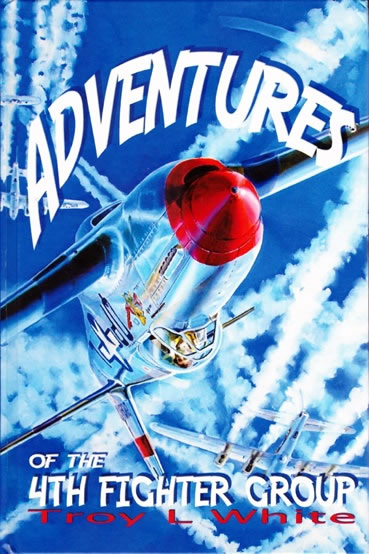Adventures
of the 4th Fighter Group
by Troy L. White

Stardust Studios
S u m m a r y : |
Catalogue Number: |
Adventures of the 4th Fighter Group
ISBN: 978-0-578-16605-1
Author: Troy L. White |
Contents & Media: |
Hardcover, 6 x 9”, 338 pages, numerous monochrome photos. (Also available as a softcover and the option of a Deluxe Edition with colour plates) |
Price: |
Available on-line from Stardust Studios:
|
Review Type: |
First Read. |
Advantages: |
An easy read full of interesting accounts and historical data. |
Disadvantages: |
No digital format offered. |
Conclusion: |
This book is must-have for fans of the 4th FG, with its blend of personal accounts and tabulated data. The numerous images should assist modellers of individual aircraft to some degree as well.
4th FG aficionados aside, the book is an entertaining read that captures the atmosphere of the time through personal accounts. These are both inspiring for their bravery and commitment to a cause, and all too often tinged with sadness through sacrifice.
Four format options and price-points are offered, but these do not include a digital option.
The format of brief accounts makes ideal reading for filling in short intervals like travelling on the bus or even sitting on the loo! I recommend it. |
Reviewed by Mark Davies

HyperScale is proudly supported by Squadron.com
The 4th Fighter group was born out of the three American Eagle Squadrons Nos 71, 121 and 133. These squadrons were made up of American pilots who made their way to England to fly and fight with the RAF against the Luftwaffe before America entered WWII.
In September of 1942 the three squadrons were officially turned over by the RAF to the fledgling 8th Air Force and became the famous 4th Fighter Group. The three squadrons were then renamed the 334th, 335th & 336th.
With over 1000 Nazi aircraft destroyed the 4th FG was the highest scoring American unit in Europe during the war.
Five years later the 4th now designated as the 4th Fighter Interceptor Wing was the first American unit to take the new F-86 Sabre into combat against the MiG-15 fighters being flown by Communist Chinese, Russian and North Korean pilots. When the conflict ended in the summer of 1953 the 4th FIW was once again the highest scoring USAF outfit accounting for 54% of all enemy aircraft destroyed.
Hence the motto “Fourth but First”.
Source: Stardust Studios
The title and cover art give an initial impression of this book being a rollicking “Boys Own Adventure” type of book, as was common in the 1950’s and 60’s. The Author’s note harks back to this period when, as a young boy thumbing through his father’s photo album, he realised his father had served in the 4th FG in WW2. This combined with the author’s own cover art may explain the presentation style.
The book has three major sections covering the RAF’s Eagle Squadrons; the formation of these RAF units into the 4th FG; where ex-Eagle pilots still dominate the story; and then the later period where the 4th’s personnel were USAAF trainees.
The style of these first three sections is the same, featuring a few pages of easy to read narrative focused on an individual’s experiences. Typically, this will include a brief personal background and mention of initial training, operational accounts that are often in the subject’s own words, tails of escape and capture where applicable, or sadly, and all too often, loss in action. Each account ends with mention of the pilot’s victories and decorations, and a photo of the individual is also included.
These sections obviously include famous 4th FG leaders and aces, but also cover less well-known but equally interesting characters. Forty-two so such stories are recounted.
A bi-product of these individual accounts is an overview of Operation Jubilee when the Eagles were first blooded supporting the Dieppe landings, the transition from Spitfires to Thunderbolts and then to Mustangs, the introduction drop-tanks, and of course the P-51’s impact on long-range missions and defeating the Luftwaffe.
Other smaller sections of the book include an epilogue, images mainly of aircraft, and several appendices covering:
-
Pilot Data.
-
Commanding Officers.
-
Aces List.
-
POW, MIA, KIA List (includes aircraft type, serial number and date).
-
Aircraft flown by the 4th FG.
-
Glossary.
-
Bibliography.
A period-feel is lent to the appendices by the inclusion of Sgt. Don Allen’s Club Decoration cartoons.
Example views of the book’s contents can be seen by clicking here. Once the book’s cover appears just click on it to turn the pages or use the slide-bar beneath the book.
The book is available in four printed formats, a standard and deluxe edition, the latter featuring colour plates, with each available in soft or hardcover. My review copy was a hardcover standard edition. Unfortunately for Kindle users and the like there does not appear to a digital option.
This book is must-have for fans of the 4th FG, with its blend of personal accounts and tabulated data. The numerous images should assist modellers of individual aircraft to some degree as well.
4th FG aficionados aside, the book is an entertaining read that captures the atmosphere of the time through personal accounts. These are both inspiring for their bravery and commitment to a cause, and all too often tinged with sadness through sacrifice.
Four format options and price-points are offered, but these do not include a digital option.
The format of brief accounts makes ideal reading for filling in short intervals like travelling on the bus or even sitting on the loo! I recommend it.
Thanks to Stardust Studios for the review sample.

Review Text and Images Copyright © 2016 by Mark Davies
This Page Created on 20 April, 2016
Last updated
20 April, 2016
Back to HyperScale Main Page |
